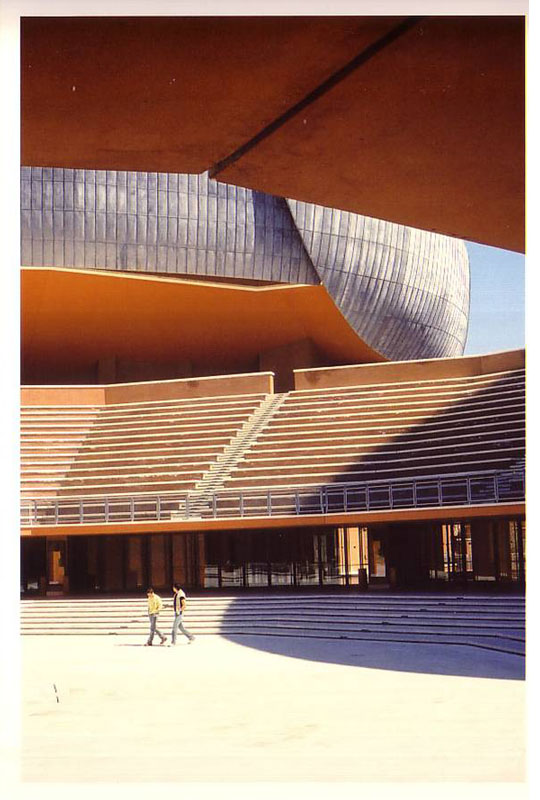Penyanyi : 7 Pritzker Laureates on the 'Challenges Ahead for the Built Environment'
Judul lagu : 7 Pritzker Laureates on the 'Challenges Ahead for the Built Environment'
7 Pritzker Laureates on the 'Challenges Ahead for the Built Environment'
"Challenges Ahead for the Built Environment" was the name of a conversation that took place at the United Nations on Tuesday evening, one day after Chilean architect Alejandro Aravena received the 2016 Pritzker Architecture Prize, also at the UN. (Watch a video of the conversation at UN Web TV.) The superstar panel consisted of Aravena, Christian de Portzamparc (1994 laureate), Renzo Piano (1998), Glenn Murcutt (2002), Richard Rogers (2007), Jean Nouvel (2008), and Wang Shu (2012).
[Montage of photos as each laureate gave their comments | Photos: John Hill]
Zaha Hadid (2004) was slated to attend, but outside of moderator Cathleen McGuigan's brief comment at the outset of the event, nothing was said about the Pritzker Prize winner less than one week after her death. Beforehand I thought her absence would color the proceedings greatly, but in retrospect I'm not surprised it didn't; this was Aravena's event, and his brand of socially conscious architecture is at odds with Hadid's and fellow partner Patrik Schumacher's fluid formalism.
The evening unfolded in a fairly straightforward manner, with each Pritzker laureate given three minutes to respond to the question: What is the main challenge ahead for the built environment. These are their responses in a nutshell, moving from left to right in the above photo montage, the way the evening unfolded:
- Richard Rogers called for architects to be seen as more than "decorators selecting the lipstick for the pig," a comment that stuck with the panel throughout the evening, even though Rogers had to leave shortly after making his remarks.
- Glenn Murcutt didn't speak about sustainability, which he is known for, opting for the challenge of social and religious prejudice. He spoke firsthand about the experience of getting a the Australian Islamic Centre built in Australia (it should be done in a couple months). His comments were the most personal, emotional and lasting.
- Christian de Portzamparc lamented the parts of the cities and suburbs that separate us from each other, coining enclaves "tomorrow's ghettoes." He called for the need to conserve public spaces and make streets in a new way.
- Wang Shu called for maintaining links with history, particularly important in his native China where rampant high-rise development has erased traditional, small-scale areas. He recounted the difficulties – and rewards – of building the Ningbo History Museum, which reuses building materials from demolished buildings.
- Renzo Piano focused on the need to make places for people on the periphery, stating "the city of the future is the one around the current city." He used the Auditorium Parco della Musica (photo below) on Rome's periphery as an example of the importance of creating civic places in the city.
- Jean Nouvel challenged architects to fight so they have a say in the important decisions that go to politicians, bureaucrats, engineers, and others. His comments arose from the marginalization of the architect in France, where they often work for contractors instead of clients, but it brought to mind his anger and legal actions over the construction of the Philharmonie de Paris.
- Alejandro Aravena selected urban migration as the biggest challenge facing society, offering his incremental housing as one means of addressing it. He dropped stats along the lines of a city of 1 million is needed every month to house people moving to cities, but his firm Elemental has only realized a few hundred units of the incremental housing to date. This number should increase, since he ended his comments by announcing that plans of four Elemental housing projects are available for download.

[Renzo Piano's Auditorium Parco della Musica in Rome | Photo: John Hill]
Of course, all of the architects went over the allotted three minutes, so the Q&A discussion that followed was fairly short and didn't add much beyond their initial responses. One recurring comment though had to do with technology and the role of computers in design. Some of the participants, especially Murcutt and Piano, expressed severe skepticism in the use of computers in architectural design, especially the renderings that are rampant today. "Don't trust simulation" was Piano's statement that ended the night, referring to the flawed approach in making images and getting seduced by them over making architecture – not one of the biggest challenges facing the built environment, but important nonetheless.
Demikianlah Artikel 7 Pritzker Laureates on the 'Challenges Ahead for the Built Environment'
Sekian Kunci gitar 7 Pritzker Laureates on the 'Challenges Ahead for the Built Environment', mudah-mudahan bisa memberi manfaat untuk anda semua. baiklah, sekian postingan Chord gitar lagu kali ini.
0 Response to "7 Pritzker Laureates on the 'Challenges Ahead for the Built Environment'"
Posting Komentar